





Published on Mar 01, 2025
Radio controlled (or R/C) cars are battery/gas-powered model cars or trucks that can be controlled from a distance using a specialized transmitter or remote. This Radio controlled system is adopted in many vehicles like cars, boats, planes, and even helicopters and scale railway locomotives. Different types of radio controlled cars like Gasoline, nitro-methanol and electric cars exist, which are designed to be run both on and off-road. "Gas" cars traditionally use petrol (gasoline), though many hobbyists run 'nitro' cars, using a mixture of methanol, nitro methane and oil, to get their power.
Among these nitro cars, there exists different types of models based on scales like 1/8 off road nitro buggy, 1/16 nitro-t Truggy, 1/16 nitro racing buggy, 1/10 nitro buggy cars etc. Mostly these car are used for participating in racing competitions held in different college technical fests with the event names like MINI-GP, GRAND PRIX, FIRE AND ICE etc. Here, we have designed and fabricated a 1/8 off road nitro buggy car to participate in the MINI GP event OF BITS Hyderabad technical fest, FIRE and ICE event of IIT Madras technical fest and in many more competitions.
The design and structural analysis of the NITRO BUGGY CAR was done by using SOLID WORKS software. After the successful design of the car, it was set for fabrication where chassis, steering arms, shock towers etc were fabricated. Finally, after fabrication and assembly, the car was set to run.
Radio controlled (or R/C) cars are battery/gas-powered model cars that can be controlled from a distance using a specialized transmitter or remote. The term "R/C" has been used to mean both "remote controlled" and "radio controlled", where "remote controlled" includes vehicles that are connected to their controller by a wire, but common use of "R/C" today usually refers to vehicles controlled by a radiofrequency link. This article focuses on radio-controlled vehicles only. Most fuelpowered models use glow plug engines, small internal combustion engines fueled by a special mixture of nitro methane, methanol, and oil (in most cases a blend of castor oil and synthetic oil). These are referred to as "nitro" cars. Recently, exceptionally large models have been introduced that are powered by small gasoline engines, similar to string trimmer motors, which use a mix of oil and gasoline.
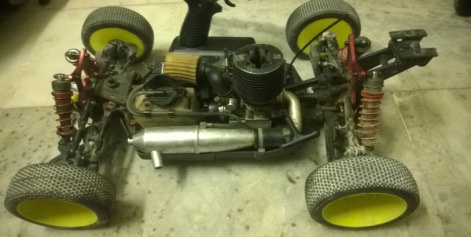
Transmitters send radio waves or electromagnetic frequencies to an RC car or other remote controlled device. The operator moves the controls on his remote control radio. The transmitter talks to the receiver via the radio carrier wave. The receiver can be a circuit board with internal antennas or a larger antenna on the exterior of the remote controlled car. Any radio signals coming from the transmitter end up at the receiver.
The receiver then converts these signals for the servo motor. The receiver transforms all radio signal broadcasts received from the transmitter into the suitable electronic signals that are required for all other components within the control system. Many of the available systems apply the amplitude modulation for the radio signals, and then they encode positions using pulse width modulation. The radio is wired up to either electronic speed controls or servomechanisms which perform actions such as throttle control, braking, steering, and on some cars, engaging either forward or reverse gears.
Electronic speed controls and servos are commanded by the receiver through pulse width modulation; pulse duration sets either the amount of current that an electronic speed control allows flowing into the electric motor or sets the angle of the servo. On the models the servo is attached to at least the steering mechanism, rotation of the servo is mechanically changed into a force which steers the wheels on the model, generally through adjustable turnbuckle linkages. Fuel powered models utilize a servo for throttle and braking control; rotation of the servo in one direction will cause the throttle on the carburetor to open, providing more air and fuel mixture to the internal combustion engine. Rotation of the servo in the other direction causes torque to be applied to a piece which causes friction with the braking material.
A small internal combustion engine is typically used in model aircraft, model cars. NITRO Engine: A nitro engine generally refers to an engine powered with a fuel that contains some portion (usually between 10% and 40%) of nitro methane mixed with methanol. Nitro methane is a highly combustible substance that is generally only used in very specifically designed engines, and is primarily used almost entirely by itself in certain of automotive drag racing. Most gas R/C models use a 2- or 4-stroke glow engine, sized specifically for that model. Most glow engines have a simple ignition system that uses a glow plug rather than a spark plug so there's no coil, magneto or points. The glow plug is heated by a battery operated glow starter. When fuel enters the combustion chamber, it's ignited by the heated glow plug and with that, the engine springs to life, instantly gaining the momentum to continue running after all the starter accessories are removed. The engine's carburetor supplies the fuel and air needed for combustion.
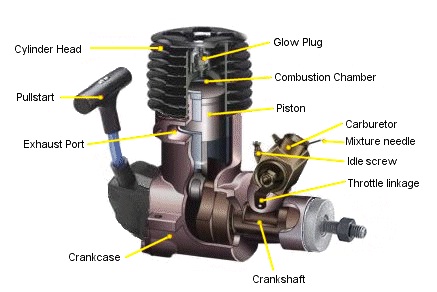
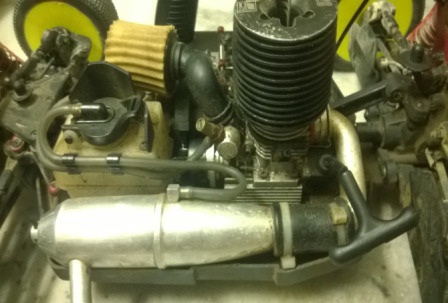
The rectangular, usually aluminum or carbon graphite frame, supported on springs and attached to the axles, that holds the body and motor of a radio controlled car. The chassis should be light in weight; strong and also able hold all the body components.
(Receiver and Transmitter) Radio control system is required to control the I.C. engine car. Throttle and steering are both taken car by a Remote Control set which consists of a receiver, transmitter and servo motor.
The receiver is a small rectangular device mounted on the car. It has a wire (usually 19") that acts as an antenna to receive signals from the transmitter. Nitro cars need a 3-channel radio control system. 2-channels for the 2 servos connected to the receiver and the third channel is connected to the battery as the receiver needs a 6-volt supply to run.
The transmitter is the controller. Transmitters have control sticks, triggers, switches, and dials at the user's finger tips. The stick type used two "sticks". The left stick is used to control the speed of the car, and the right stick is used to steer the car. The pistol type uses a "trigger" and a steering wheel. The trigger is used to control the speed of the car, the wheel to steer the car.
A servo normally has a plastic outer body with a small but very powerful electric motor and gearbox inside. The servo’s gearbox consists of a set of plastic or metal gears.. A nitro car has 2 servos, 1 is connected to the throttle and brake and the other is connected to the steering assembly of the car. The servo connected to the carburetor controls the speed of the car. It also controls the braking mechanism. The second servo is connected to the steering mechanism, controlling the direction of the car's front wheels. They all have the standard three pin connectors, with ground (black), +4.8 to 7.4V voltage (red), and signal (white).
The most common chemistries for RC applications are NiMH or NiCd and Lithium Polymer batteries. The ratings on batteries are: mAh or Ah, S and P, C. There are different types of battery chargers like slow charger, fast charger, lithium charger and filed chargers.
A rechargeable Glow plug igniter is required to start a Nitro Engine. We should always use a rechargeable version as it gives a much better glow.
Fuel tank is a box like tank in r/c car where fuel is kept. A 125cc fuel tank with open capacity plug is used.
Nitro engines typically use a carburetor to mix the fuel and air together, although for some applications where throttling is not required they have a simple venture with a spray bar and needle valve. The carburetors usually feature 2 needles used to tune the mixture. A high speed needle tunes how much fuel is allowed into the carburetor at mid to high RPM, and a low speed needle determines how much fuel is allowed into the carburetor at low to mid range RPM.
Turning either needle in a clockwise motion will thin the fuel mixture. Lean describes the amount of fuel in the fuel / air mixture. To a point this will make the engine run faster with better performance, but once too lean the engine will overheat, and wear out prematurely due to not receiving enough lubrication. Turning either needle counterclockwise will enrich the fuel mixture.
The basic function of this system is to steer the car in desired direction without putting much effort by the diver. This can be achieved by following some specific geometry while installing the wheels and parts attached to the wheels. Steering geometry is the mechanics of keeping the front wheels in proper relative alignment as the wheels are turned. It describes the angular relationship between front wheels and parts attached to front wheels and the car frame. Factors that to be considered for steering are Steering stability, Tyre wear and steering comfort of the car. Thus the steering depends on following factors
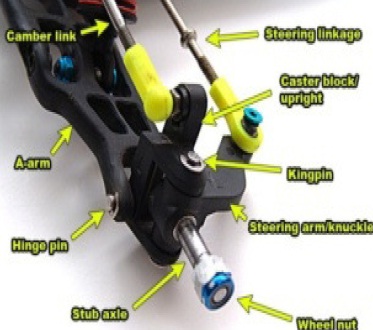
The outward tilt of the front wheels from the vertical plane at the top is called as Positive camber. If the wheels are tilted inward then it is called ‘Negative camber’, in this case the reaction force on the wheels, which act through king pin, creates some bending action on the pivots. If the wheels are cambered, when the vehicle is loaded, the load will tend to bring the wheels near the vertical position.
King pin inclination is the angle between king pin and vertical axis from the vehicle front view. This also provides direction stability along with caster. It also reduces excess camber and provides self centring action.
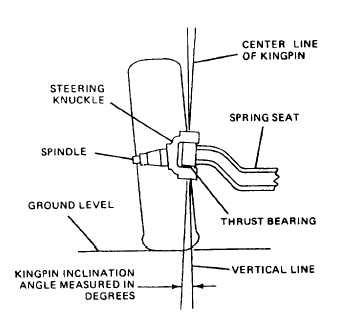
From the top view, if the front part of wheels is pointing outward and back part inward then it is called toe out. During turns, inner wheel has to rotate more than the outer wheel. Due to toe out, as the inner wheel is already turned, it takes less time to take turn. Toe out increases cornering ability of fast moving vehicle. If the front part of wheels is pointed inward then it is toe in. When the wheels are positively cambered, then the vehicle tends to move outward. Basic parts of steering system: Kingpin, Steering arm, Stub axle, Steering linkage (tie rods), Camber link, Servo motor
A glow or nitro engine uses a small glow plug. Although the plug needs to be heated up using a glow plug igniter initially, once the engine is running, the heat generated within the combustion chamber keeps the plug glowing constantly and is thus able to ignite the fuel- air mixture on each revolution
The suspension of an RC car is usually a plastic or metal piece mounted low and called an "a-arm." This connects to the chassis and to a smaller part (hub carrier or caster block) that ultimately holds the wheel. The a-arm is hinged at either end to allow up & down movement. Above the lower a-arm is either another (upper) a-arm or a thinner, simpler "camber link." This is roughly parallel to the lower a-arm and keeps the wheel standing straight up.
Nitro fuel is used in the car. This fuel is also called as glow fuel or hobby fuel. It is generally a mixture of methanol, nitro methane and oil. Methanol is usually the primary ingredient, as it provides the bulk of the fuel and is also needed as a solvent for the other ingredients. Nitro methane is generally added to the methanol to increase power and to make the engine easier to tune. It comprises of 20-25% of glow fuel. Most model engines require oil to be included with the fuel as a lubricant and so model engine fuel is typically 8‐22% oil. The most commonly used lubricants are castor oil and synthetic oils
• Length: 515 mm; Front Width: 307 mm; Rear width: 303 mm; Height: 188mm; Wheel base : 325-330 mm; Weight – 3300gms
• Camber (rear -0 ͦ and front- 2 ͦ); kick up angle -15 ͦ and toe in -5 ͦ
• 2.4 GHz radio system with metal gear servos
• Soft 16mm pro shock springs
• Dual fiber dick brake
• 4.5cc nitro engine
We used aluminum alloy 7075-T6 of 4mm thickness for making the compact chassis and Shock towers for its excellent corrosion resistance, good mach inability and good weld ability It also has many structural applications with high strength and can be heat treated. First we started by plotting the complete nano chassis and studying its various regions of weight distribution for a vehicle to have good cornering speed and no drag with aerodynamic efficiency it should have a uniform weight distribution. The centre of mass of the vehicle should also be as low as possible, so that when it absorbs a major impact and tend to topple, there will be a very good chance that it will land perfectly. First we measured the chassis and took the dimensions.
Then we displaced the engine mounts to a bit centre to make the weight distribution uniform. We designed the entire model in solid works and did stress analysis and dynamic analysis. We found out the factor of safety to be around 2.5 in front impact, side impact and rear impact with minimum deflection. Before starting the CNC Process the design was opened in the CNC Machining software and G-Code was generated for the control console, its a CNC Machining language that controls feed rate, co-ordination, location and speeds. Then we did a trial run which is referred as "cutting air" and it was perfect without any problems. Now CNC process is carried out for both chassis and shock towers in which milling and cutting was done in the beginning with coolant on, then drilling of holes is done followed by filing of the work
There is a wide scope for gaining knowledge on vehicles by studying these RC cars. One can get complete knowledge of an four wheeled automobile vehicle like Santro, Wagon R, etc because all these vehicles include similar components like engine, steering system, braking system, suspension system etc of a radio controlled car. The design and manufacturing of this type of cars by engineering students builds up their design skills, team work skills and also provides them scope to get placed in automobile core companies like TOYOTA, Mahindra & Mahindra and FIAT etc.
The problem statement of all national level technical fest competitions mentions that parts like chassis, shock towers, suspension arms etc needs to be designed and manufactured. We have designed and manufactured almost all the parts like Chassis, Steering mechanism (heim joints and the steering rods), shock towers and suspension arms to participate in national level technical fest events.
Keshav Jha, Sai Phanindra Dinesh Kakarlamudi, Bharath Konduru, Mukesh Reddy Vadala, Shravani Rallapati, Sonu Gupta and Chanikya Virugadinla
[1] IIT BOMBAY, TECHFEST 2010-11, PDF’s.
[2] http://www.meadinfo.org/2009/07/design-and-fabrication-of-icengine. html
[3] https://en.wikipedia.org/wiki/Radio-controlled_car
[4] http://www.rcuniverse.com/forum/forum.php
[5] http://www.rc-help.com/forum.php